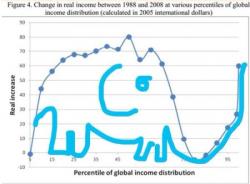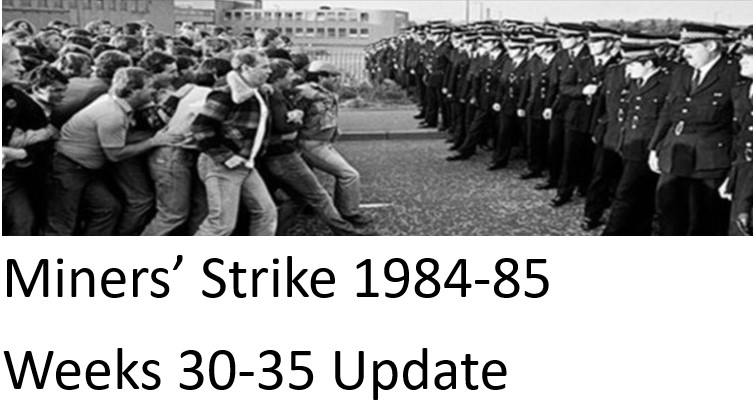By Michael Roberts
Branko Milanovic is the world’s leading expert on global inequality i.e the differences in income and wealth between countries and between individuals in different countries. He was a former chief economist at the World Bank. After leaving the bank, Milanovic wrote a definitive study on global inequality which was updated in a later paper in 2013 and finally came out as a book in 2015, Global Inequality. In his earlier papers and in that book, Milanovic presented his now famous ‘Elephant chart’ (shaped like an elephant, see above) of the changes in household incomes since 1988 from the poorest to the richest globally. Milanovic shows that the middle half of the global income distribution have gained 60-70% in real income since 1988 while those nearer the top group had gained nothing.
Milanovic found that those who have gained income the most in the last 20 years are the ones in the ‘global middle’. These people are not capitalists. These are mainly people in India and China, formerly peasants or rural workers have migrated to the cities to work in the sweat shops and factories of globalisation: their real incomes have jumped from a very low base, even if their conditions and rights have not.
The biggest losers are the very poorest (mainly African rural farmers) who have gained nothing in 20 years. The other losers appear to be some of the ‘better off’ globally. But this is in a global context, remember. These ‘better off’ are in fact mainly working class people in the former ‘Communist’ countries of Eastern Europe whose living standards were slashed with the return of capitalism in the 1990s and the broad working class in the advanced capitalist economies whose real wages have mostly stagnated in the past 20 years.
Faster population growth
However, the UK think tank, the Resolution Foundation has taken Milanovic’s elephant graph to task. Faster population growth in highly populated countries like China and India distorts his conclusion that middle income people in the globe made such strides. Controlling for the huge population rise in China and India shows that inequality between the average person in the imperialist economies of the West (North?) has increased, not decreased, compared to the poor economies of the global periphery (South?). The elephant disappears.
In his 2015 book, Milanovic concludes that there is no longer any social or economic basis for class struggle of a socialist revolution. So we must look for ways to make capitalism better and fairer. “Global inequality may be reduced by higher growth rates in poor countries and through migration.” Now in his new book, Capitalism Alone, Milanovic returns this theme and his ‘way out’. Again he starts from the premise that capitalism is now a global system with its tentacles into every corner of the world driving out any other modes of production like slavery or feudalism or Asian despotism to the tiniest of margins. But also capitalism is not just only mode of production, it is the only future for humanity.
“Capitalism has triumphed because it works…”
So he says “Capitalism gets much wrong, but also much right—and it is not going anywhere. Our task is to improve it.” Milanovic argues that capitalism has triumphed because it works. It delivers prosperity and gratifies human desires for autonomy. But it comes with a moral price, pushing us to treat material success as the ultimate goal. And it offers no guarantee of stability. In the West, ‘liberal capitalism’ creaks under the strains of inequality and capitalist excess. That model now fights for hearts and minds with what Milanovic calls “political capitalism”, as exemplified by China, which many claim is more efficient, but which is more vulnerable to corruption and, when growth is slow, social unrest.
Milanovic condemns inequality “I think it is bad for growth. It is bad for social stability, and it is bad for equality of chances, or equality of opportunity.” And capitalism is bad because it inherently increases inequality. “The system, the way it functions today, is generating — and, I’ll actually give it two examples — generating, really increasing, inequality. And that increasing inequality leads to the control of the political process by the rich. And, the control of the political process by the rich is really required for the rich to transfer, or transmit, rather, all these advantages. Be it through money — financial advantages – or, education, to their offspring. Which then reinforces the dominance of whatever is called the upper class.” Yes, that sounds like capitalism.
So Milanovic favours increased spending on public goods and services (including education) and social insurance – and the introduction of taxes on rich’s property and wealth, in order to end inherited dynasties, so that you can only get rich by merit and hard work – as if you ever did! So his answer to a better capitalism is the same as in his previous book, but this time with a degree of more optimism about achieving it: namely reducing inequality and expanding migration from poor to richer countries.
Riddled with corruption
Although both capitalist ‘alternatives’ are riddled with corruption in their elites and state institutions, it is clear that Milanovic puts more faith in getting a return to the ‘liberal democratic’ model of Western (‘northern’) imperialism than he does for the ‘political capitalism’ of China. But is Milanovic right to define the new cold war between Chinese and American capitalism as a contest between the liberal and the authoritarian, the meritocratic and the political?
Can we really accept this when we see Trump’s America; the callous and often brutal imperialist hegemony of the United States; and the corrupt money-bags ‘democracy’ that operates there, with its extreme and rising inequality. And can we really describe China, an authoritarian and corrupt state regime, as ‘political capitalism’?
As regular readers of this blog will know, I am not convinced that China is capitalist at all, given the overriding economic power of the state and its plan compared to the capitalist sector. The lives of Chinese are much more decided by the state and state enterprises than through the vagaries and uncertainties of the market and the law of value. As Milanovic says, China has grown in real GDP and average living standards in 70 years faster than any other economy in human history. So is this really a demonstration of a successful capitalist economy (when all other capitalist economies only achieved less than a quarter of China’s growth rate and were subject to regular and recurring slumps in investment and production)? Could not China’s different narrative be something to do with its 1949 revolution and the expropriation of its national capitalist class and the removal of foreign imperialism? Perhaps capitalism is not alone after all.
Is socialist ruled out ‘forever’ ?
So Milanovic’s dichotomy between ‘liberal democracy’ and ‘political capitalism’ seems false. And it arises because, of course, Milanovic starts with his premise (unproven) that an alternative mode of production and social system, namely socialism, is ruled out forever. In Global Inequality, Milanovic concluded that the idea of a united global proletariat making a worldwide revolution is out of the door because now the real inequalities are between Americans and Africans, not between capitalists and workers everywhere. Trotsky’s international proletarian revolution is out of date: “This was the idea behind Trotsky’s “permanent revolution”. There were no national contradictions, just a worldwide class contradiction. But if the world’s actual situation is such that the greatest disparities are due to the income gaps between nations, then proletarian solidarity doesn’t make much sense. Proletarian solidarity is then simply dead because there is no longer such a thing as global proletariat. This is why ours is a distinctly non-Marxian world.”
And yet the working class, both industrial workers and those in so-called ‘service’ industries, has never been larger in human history. Globally, there were 2.2bn people at work and producing value back in 1991. Now there are 3.2bn. The global workforce has risen by 1bn in the last 20 years. Globally, the industrial workforce has risen by 46% since 1991 from 490m to 715m in 2012 and will reach well over 800m before the end of the decade. Indeed, the industrial workforce has grown by 1.8% a year since 1991 and since 2004 by 2.7% a year, which is now a faster rate of growth than the services sector (2.6% a year)! Globally, the share of industrial workers in the total workforce has risen slightly from 22% to 23%. Capitalism is not alone; it has a gravedigger, the proletariat.
Milanovic sees no alternative to capitalism
Milanovic dismisses this. In his new book, “I do believe, to a large extent, [capitalism] is sustainable. Even if all of inequality continue[s] to be the way that [it is], unchecked. It is sustainable, largely, because we don’t have a blueprint for an alternative system. However, something being sustainable, something being efficient, something being good, are two different things.” Milanovic does not like capitalism, but to use Margaret Thatcher’s phrase in referring to her neoliberal policies for capitalism: he reckons there is no alternative (TINA). So the aim must be, just as Keynes argued in the 1930s: “to make capitalism more sustainable. And that’s exactly what I think we should do now”.
The trouble is that Milanovic’s policies to reduce the inequality of wealth and income in capitalist economies and/or allow people to leave their countries of poverty for a better world seem to be just as (if not more) ‘utopian’ a future under capitalism than the ‘socialist utopia’ he rules out.
October 14, 2019
From the blog of Michael Roberts. The original, with charts and hyperlinks, can be found here.



